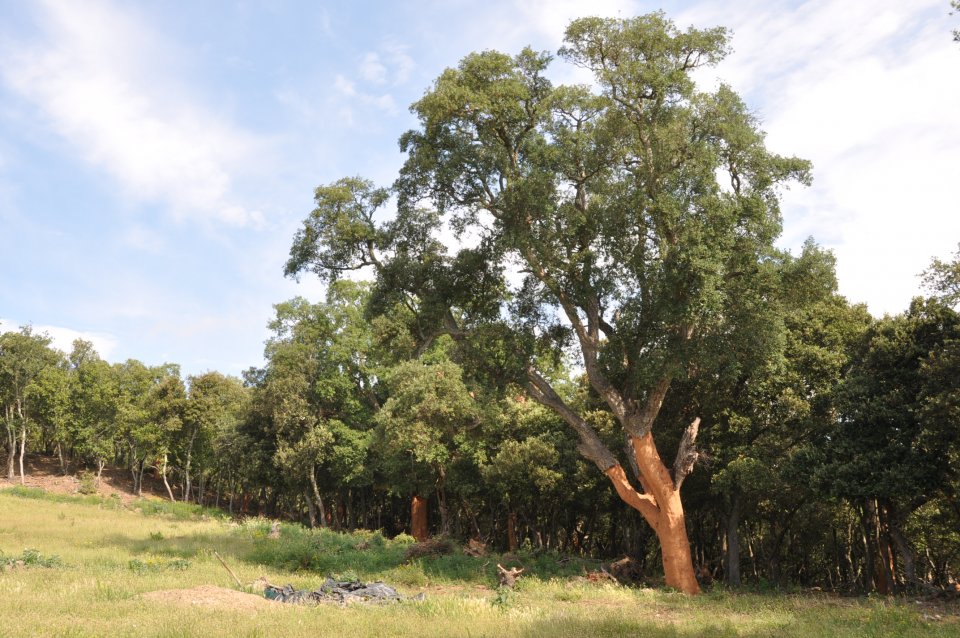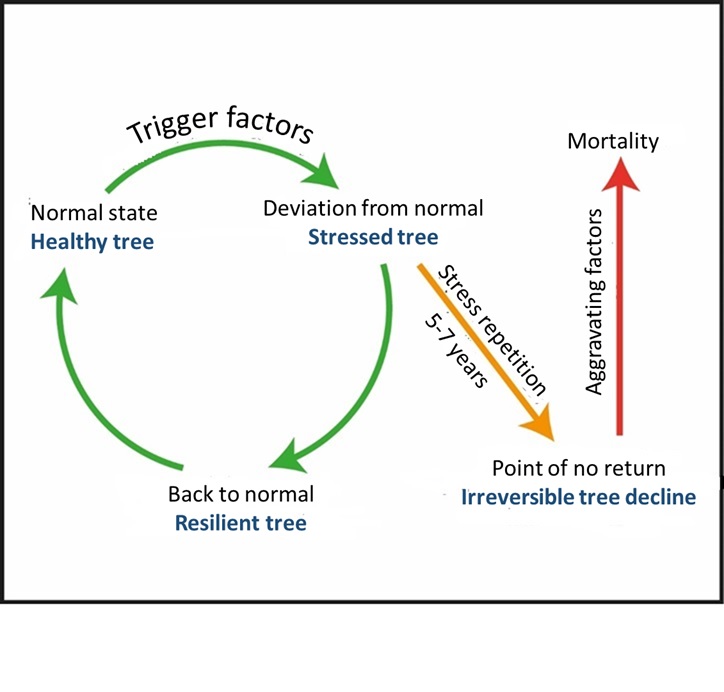
Cork harvesting, every 10 to 15 years depending on the region, requires trees in good phytosanitary conditions and is a potential source of stress, especially if debarking is poorly done. Hence the interest in having a tool to assess the trees phytosanitary conditions, which can be used as a decision support tool when carrying out silvicultural operations. This tool is based on a visual diagnostic method called Archi, developed by CNPF. ARCHI is based on the reading of tree crown architecture using a specific identification key referring to different architectural types related to resilience capacities.
The cork oak is of significant economic interest and constitutes an habitat of community interest (9330 - Quercus suber Forest) for its environmental and heritage value. Occupying mainly the hot and dry stations of the south of France, the cork oak is exposed to the effects of climate change. Since 2013, this species benefits from a phytosanitary monitoring network managed by the Department of Forest Health (DSF). To supplement these observations, as part of an Interreg POCTEFA III project entitled “ECTAdapt 4” (led by the Pyrénées-Orientales department, the Diputació de Girona and the CILMA), the CNPF and the IML were commissioned to develop a diagnostic tool for the physiological state of the cork oak.
The project initiated a study on the ontogenesis of cork oak, during the different stages of development from germination to senescence.
Thanks to the study of the morphological variations of the cork oak according to the environment (forest, outside the forest, altitude, etc.) a reference development sequence could be defined facilitating the description of the deviations from normal and the mechanisms of return to normal of the cork oak.
A key for determining the architectural types according to the degradation/restoration balance was then proposed and used in the Archi method. The Archi method defines six physiological states of the cork oak: healthy tree, stressed tree, resilient tree, tree in descent from the crown, tree in retreat and tree in a situation of irreversible decline.
The Archi method, rating the cork oak, can be applied at any season, except in spring, when it partially renews its foliage.
It is important to make observations over identical periods every 3 to 5 years. After a thinning, it is recommended to wait 2 to 3 years before the first Archi ratings to allow the trees to adapt to their new environment.
In dense and tall stands, it is sometimes necessary to cumulate observations made on different sites. In the mountains, choose the upstream position. Binoculars are mandatory (12 x 50). The use of a camera to take pictures of certain subjects is useful. If possible, it is advisable to work in pairs.
The use of the Archi method requires prior training.
The Archi method analyses the entire tree architecture and allows a double diagnosis of the development stage and the physiological state.
The Archi method provides the means not to confuse ageing and dieback and to define the reversible or irreversible character of a dieback.
This Archi method is validated for northern and southern Catalan stands and would require development in areas where cork oak silviculture has a direct impact on crown architecture (Iberian Peninsula in particular).
The Archi method assesses the resilience capacity of a tree in the face of stress, but it does not diagnose the origin of this stress.
The "Stressed" types, in reaction phase, are to be followed over time to know their evolution, improvement or degradation.
The "Retreat" types, continuing their development with the top amputated but without producing a substitute, require monitoring.
The widespread increase in the proportion of the "Irreversible Wasting" type, outside of any epidemic disease, needs to be monitored to reveal the negative effects of climate change.
Work is under way in the Interreg Sudoe ForManRisk project to adapt the Archi method to cork oak stands in south-west France and the Iberian Peninsula.
Christophe DRENOU, christophe.drenou@cnpf.fr, https://www.cnpf.fr/n/le-service-de-recherche-et-developpement-r-d-du-cnpf/n:1469
Renaud PIAZZETTA, institutduliege@free.fr, http://www.institutduliege.fr/
Further information
Drénou C., Caraglio y., (2019) Parlez-vous Archi ? Les principales définitions de la méthode Archi. Forêt Entreprise, 246, 28-35.
De Reffye P., Jaeger M., Barthélémy D., Houllier F., coord. (2018) Architecture des plantes et production végétale. Les apports de la modélisation mathématique. Editions Quae. Versailles, 358 p.
Drénou C., Bouvier M., Lemaire J., (2011) La méthode de diagnostic ARCHI. Application aux chênes pédonculés dépérissants. Forêt entreprise, 200, 4-15.
Serge Peyre-CD66

Schematic diagram principle Archi method. Christophe DRENOU-CNPF
